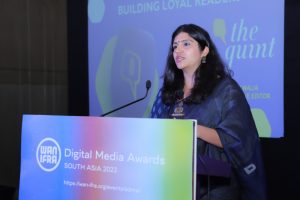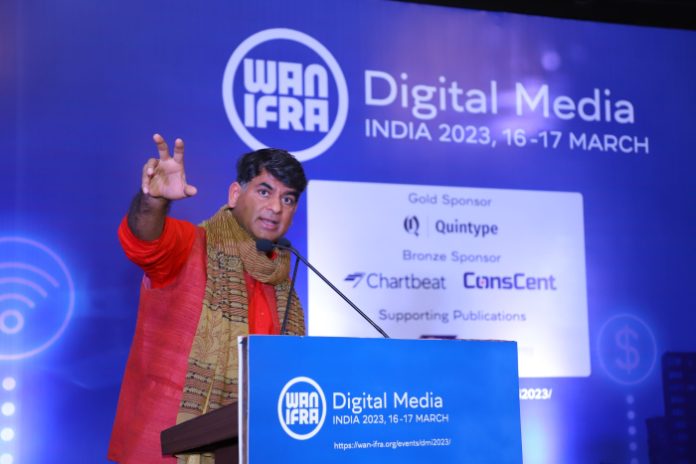How does digital news media survive in a world dominated by the social media university and unverified WhatsApp forwards – in other words fake news? One way to build trust and loyalty among readers is credible journalism armed with the right marketing strategy. And this goes for both legacy as well as independent new-age media. In fact, ‘nothing else but credible journalism works’ was the key refrain at the Wan-Ifra Digital Media 2023, held on 16 and 17 March 2023 at New Delhi’s Aerocity Business district.
From The Quint co-founder and CEO Ritu Kapur to Manorama Online CEO Mariam Mammen Mathew; to LV Navaneeth, CEO of The Hindu Group; Bharat Gupta, CEO of Jagran New Media, to Nandagopal Rajan, editor New Media & Business Head, Indianexpress.com; ABM Jabed Sultan, chief business officer, Prothom Alo Digital, Bangladesh, to Saurabh Dwivedi, editor, The Lallantop, to Siddharth Varadarajan, founding editor, The Wire – all were unanimous about one aspect – that only journalism can save journalism. Journalism that involves getting to ground zero, digging out the right issues that concern the common man on the street, and making the right connect with people with some smart planning.

A few case studies, though, threw up some interesting insights on how digital media can get its act right to scale up operations and build a base. Here we analyze how new-age media ventures The Lallantop and The Quint as well as legacy media organizations The Indian Express and Prothom Alo of Bangladesh managed to get all the ticks right on the digital checklist.
The Indian Express: Digital carves its own identity
The legacy newspaper The Indian Express is nationally published and distributed. It is known for delivering quality, credible, and trustworthy investigative journalism, but at the same time with its limited circulation, is not a mass-selling product like, say, The Times of India or Hindustan Times. In contrast, its digital avatar Indianexpress.com is one of India’s top news websites – it is a completely different ballgame with some 60 million visitors to its site each month, as explained by Nandagopal Rajan.
So how did it manage this? Rajan said it leveraged the legacy of the print newspaper, which was founded in 1932, to go digital-first, launch premium sections, and build a separate identity for the digital section – a strategy that helped add and retain subscribers as well as scale up revenue. “It’s a trusted brand, and that’s something we take very seriously. Our only business is credibility, and it’s something we cannot lose at any cost,” Rajan said.
Indianexpress.com won two Gold medals in Wan-Ifra’s South Asian Digital Media Awards for Best Newsletter (Your Morning Expresso) and Best Digital Subscription Initiative (Bronze in the Podcast category). In fact, newsletters and social media were part of the company’s key strategic devices to build engagement among readers.
The website is built on the newspaper’s key strengths and USPs – Explained, an explanatory section has a massive following; the high-impact Opinion section; its extensive City coverage with its vast network of on-ground reporters; and, the UPSC-related news for civil service aspirants. Armed with such high-value content, the group went digital-first with its coverage and broke the shackles of the print news cycle – stories started flowing in, as and when they happened.
Rajan explained that the readers were willing to pay for quality journalism as “Loyal readers don’t need discounts, they are happy to pay for Express Promise.” For fence-sitters, though, there were discounts. Subscribers, Rajan explained, paid for daily premium stories, access to archives, the daily ePaper edition of their choice, daily Sudoku and crosswords, early access to specials, and invites to express events. Together these strategies paid off and Indianexpress.com is consistently ranked among the top five news websites in India, hitting over 60 million monthly UVs, he said.
Prothom Alo – Print and digital stay ahead
Another interesting case in point is Bangladesh’s largest daily newspaper Prothom Alo with a daily readership of 5 million, whose digital edition went all guns blazing to become the top-read news portal in the country – thanks to an innovative approach.
ABM Jabed Sultan, the chief business officer of Prothom Alo Digital, explained the growth journey to the top. Content around fashion, teenagers, and science as well as eCom, OTT, branded content (both text and videos) events, and job fairs, are some of the USPs of ProthomAlo.com, which has 300 million page views, 17 million monthly readers, and 1 billion monthly ad impressions in a 2,000-crore Bangladeshi Taka digital ad market.
Prothom Alo has been recently in the news for another reason – alleged intimidation and harassment, as claimed by Amnesty International. According to Amnesty, Bangladesh prime minister Sheikh Hasina recently called Prothom Alo “an enemy of the Awami League, democracy, and the people of Bangladesh,” while speaking in Parliament. She was referring to an article published by the media outlet on the Independence Day of the country, covering the cost of living in Bangladesh.
The journalist who wrote the article, Shamsuzzaman Shams was arrested and later granted bail. The editor of Prothom Alo, Matiur Rahman, was sued and named as the main accused in one of the two cases against Shams, Amnesty said. A group of individuals barged into Prothom Alo’s office in Dhaka, issued threats, and vandalized its logo.
“Penalizing a media outlet, publisher or journalist solely for being critical of the government or the policies it promotes is a restriction of the right to freedom of expression that can never be justified,” said Yamini Mishra, regional director for South Asia at Amnesty International.
At the Wan-Ifra South Asian Digital Media Awards 2022, Prothom Alo bagged bronze for its New Subscription Model; Silver in Audience Engagement for its Padma Bridge Inauguration Campaign; Bronze for the Best ePaper-Concept; Gold and Silver for the Best Digital Advertising Project.
The Lallantop: Connecting with audiences
Coming back to new-age media platforms, The Lallantop, a vernacular digital-first news venture from the India Today group, is another digital success story. It has more than 24 million subscribers on YouTube, with an average of 0.22 million views per video and over 280 million monthly views. On Facebook, the brand clocks in about 100 million monthly views.
And how did it achieve all this? Saurabh Dwivedi, the editor of The Lallantop, explained that its motto of staying ‘real, raw and relatable’ made an instant connect with readers as its journalists got cracking on the ground to get the nerve of the masses rather than thrusting news on the audiences.
Speaking at Wan-Ifra’s Digital Media India, Dwivedi spoke about the rise of language journalism in India and offered insights into some of the best brand practices that others can emulate.
“To truly connect with the people on the ground, you need to leave your power position and take authentic interests in their lives and vocations. Don’t start bombarding them with political questions – who will you vote for? It’s a secret ballot, why will they tell you?” Dwivedi said. “However, if you talk to them genuinely, they will share their concerns with you.” He was narrating the platform’s experiences during the 2017 Uttar Pradesh assembly elections. Reporting live from the ground where emotions ran high, he said, the brand directly connected with the audience and resonated with viewers.
The Quint: Targeting the young brigade
The Quint, a general news and opinion website, is another new-age media outlet that has managed to make an impact among young readers. With 25 million monthly active users and 125 million page views, it has 3 million Facebook followers, 3 million YouTube subscribers, and 1 million Instagram followers, explained Shelly Walia, The Quint’s executive editor. About 70% of its audience is below 44 years of age, with 60% from Tier 1 cities and 40% from Tier 2 and Tier 3 cities.
Walia said when they started out, traffic and page views were the focus but over time, they started concentrating on their loyal audience members. The topics that paid dividends for The Quint are current affairs, politics, gender, health, videos, caste issues, explainers, opinion, and the Indian diaspora. Another focus area is its special projects that include powerful documentaries, long-form investigative reports, and deep dives into issues of social and national interest. My Report, a community platform for citizen journalists, and its fact-checking arm WebQoof are also a major draw.
A few strategies that have paid off for The Quint are: incentivizing login via ad-free experiences, with options to save stories, and recommended content. The readers appreciate a sense of community by inviting feedback, taking suggestions and members’ opinions, and giving early access to special projects, membership discounts, and members-only newsletters and reader surveys.
The Quint received three Golds, two Silvers, one Bronze, and the ‘Champion Publisher of the Year 2022’ at the media awards.

















